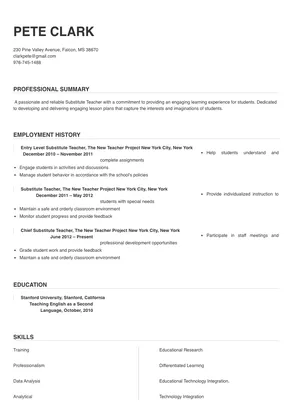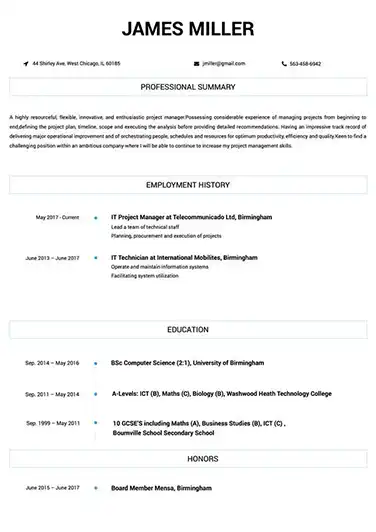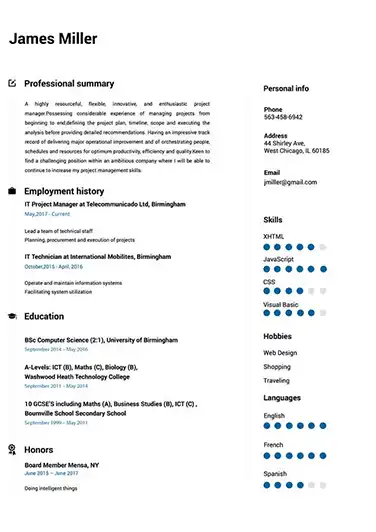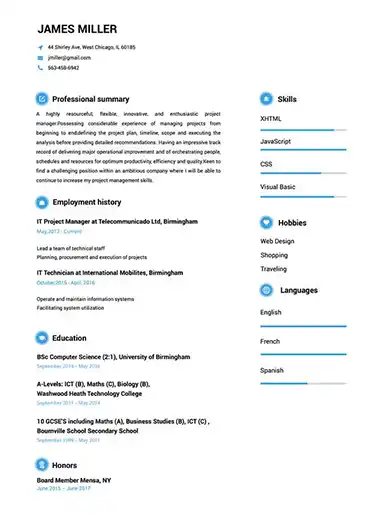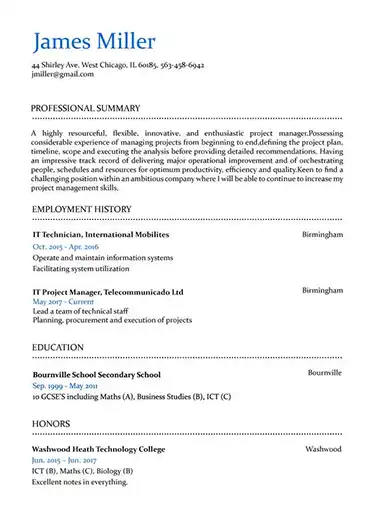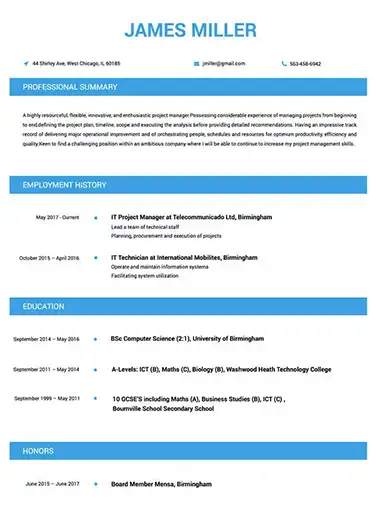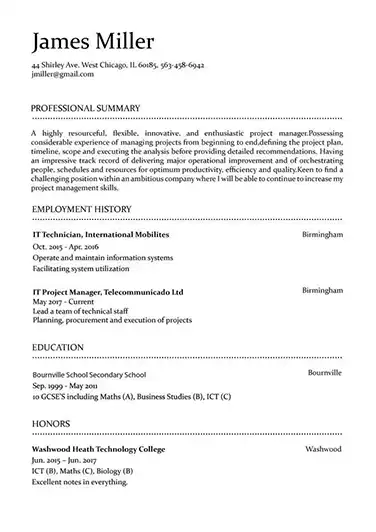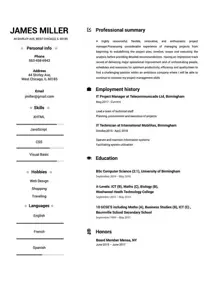 Use This Template
Use This Template
Build your resume in 15 minutes
Create an awesome resume that meets the expectations of potential employers with our selection of professional, field-tested resume templates.
substitute teacher: Resume Samples & Writing Guide
clarkpete@gmail.com
976-745-1488
Professional Summary
Employment history
- Participate in staff meetings and professional development opportunities
- Grade student work and provide feedback
- Maintain a safe and orderly classroom environment
- Provide individualized instruction to students with special needs
- Maintain a safe and orderly classroom environment
- Monitor student progress and provide feedback
- Help students understand and complete assignments
- Engage students in activities and discussions
- Manage student behavior in accordance with the school's policies
Education
Skills
Do you already have a resume? Use our PDF converter and edit your resume.
ellis_adam@hotmail.com
645-818-7828
Employment history
- Supervise students during recess and lunchtime
- Maintain a safe and orderly classroom environment
- Assist with special projects and other duties as assigned
- Communicate with parents and other staff members
- Engage students in activities and discussions
- Administer standardized tests and assessments
- Manage student behavior in accordance with the school's policies
- Participate in staff meetings and professional development opportunities
- Maintain a safe and orderly classroom environment
Education
Skills
ingramgus5@gmail.com
792-049-7264
Employment history
- Manage student behavior in accordance with the school's policies
- Follow lesson plans and instructions provided by the classroom teacher
- Communicate with parents and other staff members
- Maintain a safe and orderly classroom environment
- Prepare and distribute materials for lessons
- Grade student work and provide feedback
- Follow lesson plans and instructions provided by the classroom teacher
- Help students understand and complete assignments
- Monitor student progress and provide feedback
Education
Skills
moore_adam@aol.com
773-776-1234
Professional Summary
Employment history
- Maintain accurate records of student attendance
- Follow lesson plans and instructions provided by the classroom teacher
- Prepare and distribute materials for lessons
- Follow lesson plans and instructions provided by the classroom teacher
- Prepare and distribute materials for lessons
- Maintain accurate records of student attendance
- Provide individualized instruction to students with special needs
- Administer standardized tests and assessments
- Maintain a safe and orderly classroom environment
Education
Skills
woodollie@inbox.com
611-110-5314
Professional Summary
Employment history
- Communicate with parents and other staff members
- Provide individualized instruction to students with special needs
- Help students understand and complete assignments
- Prepare and distribute materials for lessons
- Communicate with parents and other staff members
- Maintain a safe and orderly classroom environment
- Participate in staff meetings and professional development opportunities
- Engage students in activities and discussions
- Prepare and distribute materials for lessons
Education
Skills
Not in love with this template? Browse our full library of resume templates
The quote, “You know you’re a substitute teacher when you’re happy to hear the phone ring at 6 a.m.” perfectly encapsulates the life of a substitute teacher. It hints at both the joy that this role brings as well as the haphazardness that comes part and parcel with it.
While substitute teachers may not be recognized for their efforts in the same way that regular classroom teachers are, there’s no denying that they’re just as essential to every public and private school. After all, by stepping in for a regular classroom teacher when they’re unable to attend class, substitute teachers help ensure students’ learning opportunities aren’t disrupted.
There are a number of reasons why a substitute teacher may be called on to temporarily replace a regular classroom teacher for a single day or a longer period of time. These may include when a classroom teacher:
- Is sick
- Is involved in an accident
- Has a family emergency to deal with
- Needs to attend internal or external training
- Is required elsewhere for a specific school activity or program
Whatever the reason and for however long they’re needed, the best substitute teachers empower students to meet the high academic standards while ensuring their safety and wellbeing.
If you’re ready to step up to the challenge of becoming a substitute teacher or you simply want to receive more requests to substitute teach, keep in mind that you’ll need to provide schools with a strong resume.
The easiest way to learn how to create a resume that schools love is to read our substitute teacher resume example and complete writing guide below. You’ll learn:
- The key resume elements principals and school hiring managers are after
- Which achievements to emphasize and how
- How to work out which hard and soft skills to focus on
- The most straightforward way to target your resume for each application
- Pro tips for differentiating your resume from the competition
1. Multiple Template Examples
2. How to Write a Substitute Teacher Resume That Will Get Your Phone Ringing?
How do you format the resume?
As a substitute teacher, you’ll know better than most just how important it is to present yourself as a neat and organized professional. So why, then, should your resume appear to be any different?
The fact of the matter is that a neat and well-organized resume will attract far more attention from a principal or school hiring manager than an untidy and disorganized one. This is why it’s crucial to select the right resume format to arrange the contents of your resume.
In our opinion – as well as that of most human resources professionals – the reverse-chronological resume format does this most effectively. It’s considered to be the go-to format for experienced professionals as it organizes your resume in a way that emphasizes your career progression. It does this by presenting your most recent job first, followed by the ones that preceded it, in reverse-chronological order.
While you’re tinkering with your resume’s format, you should also bear in mind the particular layout guidelines principals and school managers prefer. For your convenience, we’ve shared the most critical ones for you to follow below:
- Number of Pages: 1 page at most.
- Fonts to Use: A conservative font that you would feel comfortable using to write to the school principal, such as Times New Roman and Cambria.
- Fonts to Avoid: Any fonts that would look right in place on a student’s artwork, such as Austiebost Crazy Days and Cherry Rush.
- Margins: 1 inch on all sides.
- Line Spacing: 1 or 1.15.
- Header size: 14-16 point size.
- Text size: 11-12 point size.
What makes a great substitute teacher resume?
A great substitute teacher resume should boast a number of key elements in order to catch the eye of a principal or school hiring manager. At its most fundamental level, a resume should be flawlessly formatted and written in a professional manner.
It should additionally be set out in a way that addresses how the candidate meets the specific criteria stated in a given job ad. In cases where a candidate wishes to submit an application to substitute teach at a school that hasn’t directly advertised for a substitute teacher, the candidate’s resume should be in line with the given school’s general values and teaching goals.
Ultimately, a great substitute teacher resume should convince whoever is reading it that the candidate is well worth hiring. A resume can do this by establishing how the candidate’s relevant professional experiences, skills, and attributes in turn make them an ideal substitute teacher to teach at a given school.
How to give principals and school hiring managers what they’re looking for by targeting your resume for each application
Now that you’ve learned about the key qualities every great substitute teacher resume should have, you may be raring to start piecing together your own.
However, it’s vital to be mindful that there isn’t just one perfect resume that will be the right fit for every job. This is because each job comes with a distinct set of criteria attached to it. After all, as every school and principal is unique, expectations for substitute teachers will vary accordingly.
This is precisely why you won’t have much luck in your job search if you simply hand in the same resume each time. If you want to score your dream substitute teaching gig, you’ll need to start targeting your resume for each application. All this requires you to do is customize your resume each time so that it showcases the precise qualities a principal or school hiring manager is looking for.
If you wish to apply for an advertised substitute teaching role, you can figure out what these qualities are by carefully analyzing the given job ad. The main thing you should be on the lookout for are ‘keywords.’
Keywords describe the words that a principal or school hiring manager has included in a job ad to convey what they’re seeking from an ideal candidate. Typically, these will be related to critical skills and competencies. Once you’ve identified these keywords, you’ll need to customize each section of your resume around them.
Conversely, if you wish to hand your resume over to a school that hasn’t directly advertised for a substitute teacher, you’ll need to take a different approach to targeting your resume. The reason being that you won’t have a job ad to refer to. Instead, you can look at the given school’s website to discover which specific qualities are valued by the school’s principal.
By doing so, you’ll be able to gain a greater understanding of the school’s values and goals, including the type of teacher and teaching styles that are preferred. Once you’ve pinpointed what these are, customize your resume so that it reflects these qualities.
Which soft and hard skills should you mention? How can you do so correctly?
If you had to add up all of the skills that you’ve drawn on throughout the days, weeks, or months that you’ve worked as a substitute teacher, it would prove to be a near impossible task. After all, there are countless skills you rely on to support the diverse range of students that you teach – and more often than not, you’ll be applying multiple skills at once!
So how do you choose which of your skills will be most worthwhile mentioning in your resume? The short answer is that for the most part, it isn’t up to you at all. The skills you feature should be a reflection of the skills that a principal or school hiring manager is seeking from a substitute teacher for their school.
As we explored further above, in order to create a great resume, you must customize your resume around the keywords you find in each given job ad (or the qualities you find on a school’s website in cases where there is no job ad). The most common kind of keywords you’ll come across is skills-focused keywords. These keywords basically describe the skills a principal or school hiring manager is looking for from an ideal candidate.
When you’re analyzing a job ad, keep your eyes peeled for two types of skills-focused keywords: soft skills and hard skills.
Soft skills are positive personality traits that describe the manner in which you conduct yourself with others as well as the way in which you perform tasks. Hard skills are technical abilities that allow you to complete the tasks expected from you. They are measurable and teachable, and are more often than not specific to each profession.
To gain a clearer understanding of what we mean, take a look at the soft and hard skills we’ve highlighted below. We extracted them straight from real-life substitute teacher job ads so that you can see some of the most sought-after skills principals and school hiring managers are looking for from substitute teachers.
Soft skills
- Positive, respectful, and professional attitude
- Remaining objective when dealing with student problems, grading, etc.
- Building mutual trust, respect, and cooperation among students, faculty, and parents
- Highly-organized
- Punctuality
- Patience
- Leadership
- Ability to follow instructions
- Oral and written communication abilities
- Working well under pressure
Hard skills
- Establishing clear objectives for all lessons and projects
- Adapting teaching methods and instructional materials to meet students' varying needs, abilities, personalities, and interests
- Developing techniques to help students improve their learning potential
- Organizing the classroom efficiently to meet the educational and physical needs of students
- Observing and evaluating students' performance, behavior, social development, and physical health
- Maintaining thorough student records to document attendance, participation, or progress
- Providing students positive feedback to encourage and help them develop an appreciation for academic achievement
- Reinforcing and rewarding appropriate social and academic behavior in the classroom
- Instructing students individually and in groups using a variety of teaching methods
- Providing a variety of materials and resources for children to explore, manipulate, and use
So the big question still remains: How do you correctly mention the soft and hard skills you find in a job ad for a role that you wish to apply for? You should naturally add them to three main sections of your resume:
- “Resume Objective” or “Resume Summary”: Mention a few relevant skills that you want the recruiter to know immediately about.
- “Skills” section: Mention 6 to 8 relevant skills in list form.
- “Employment History” section: Incorporate relevant skills throughout as many of your work achievements as possible (read the following section to learn more).
Pro tip: Only add skills from a job ad that are relevant to your unique skills set. For example, if a job ad gives preference to teachers who are skilled at teaching students with learning disabilities but you’ve never taught such students, don’t include this skill in your resume. Remember, if you’re caught red-handed embellishing your skills, your application will come to a crashing halt to say the least.
How to highlight your most important achievements
Your resume is your time to set aside any modesty you feel about your achievements as a teacher and let them shine. The main section you should do so is in your resume’s “Employment History” section.
If you’re wondering how you can narrow down which achievements to highlight, the answer is simple: look at the given job ad for keywords or the school’s website for useful insights. Yes, once again, these sources of information are the key to making a resume that principals and school hiring managers love.
This is because the achievements you include in your resume shouldn’t be picked at random. You should strategically select achievements so that you have the opportunity to emphasize the very professional experiences, skills, and qualities principals and school hiring managers are seeking from an ideal candidate.
But before you set off, don’t just carelessly plonk the keywords or qualities you’re trying to target into your achievements, like this candidate did:
- Supported students’ varying needs by using various teaching methods known to meet students' varying needs.
This achievement overuses keywords in an unnatural way, which is a phenomenon known as ‘keyword stuffing’. Keyword stuffing not only makes the candidate’s achievement sound stilted and repetitive, but it also puts them at risk of being immediately rejected for engaging in this frowned upon behavior.
Instead, use keywords naturally so that they show off your most impressive attributes. For example:
- Supported a range of students’ needs, including students with physical disabilities and learning difficulties, by implementing 3 different versions of the same lesson.
This achievement effectively incorporates keywords in a natural way to convey just how skilled the candidate is in supporting different students’ needs. The candidate not only explains how they did so, but also quantified their achievement with an eye-catching example to drive their point home.
What are ideal substitute teacher job qualifications to have? How do you list them correctly?
Unlike regular classroom teachers who must hold specific qualifications in order to work, the qualifications substitute teachers must hold are less clear-cut.
For private school substitute teachers, mandatory and ideal qualifications will vary from school to school. This is because private schools have the prerogative to decide which qualifications a substitute teacher either must have or ideally have. To learn more, you’ll need to refer to each job ad or each school’s website.
For public school substitute teachers, mandatory qualifications will vary significantly from state-to-state as well as district-to-district. As such, the ideal qualifications you should highlight in your resume will depend on which state and district you’re teaching in. To learn more, we suggest taking a read of helpful resources such as the National Education Association’s resource, Status of Substitute Teachers: A State-By-State Summary.
Below, we’ve provided some general guidelines for which ideal qualifications to include in your resume as well as how to correctly include them.
Education
Generally speaking, most states require substitute teachers to have a high school diploma or equivalent at minimum. That being said, it’s ideal for substitute teachers to have a bachelor’s degree (with some states even requiring one). In your resume, make sure to list the highest level of education you attained, in accordance with relevant school, state, and/or district requirements.
To list your educational background correctly, create an “Education” section. Be sure to include the following details about each degree or diploma:
- The name of the degree or diploma
- The concentration of your degree (if relevant)
- The name of the college or institution you obtained it from
- The state the college or institution is located in
- The years you studied the degree or diploma
For example:
EDUCATION
- Bachelor of Education, University of Connecticut, CT, 2016 - 2020
License or Permit
Some states may require substitute teachers to obtain a license or permit from the state in order to teach. It’s important to note that some states may require this in addition to a bachelor’s degree or as an alternative to one. If you’re required to hold one, you can list your license or permit in a section called “License” or “Permit” respectively. Be sure to include the following information about yours:
- The name of the license or permit
- The state it is valid in
- The year you obtained it
For example:
- Arkansas Teacher's License, 2019
Training and Certifications
As you can hazard a guess, whether you will be expected to have undertaken certain training and/or obtained a particular certification will depend on each school and/or state and district. It’s worth keeping in mind that some states will offer higher pay to teachers who hold a valid teaching certificate.
Even if not required, it’s ideal to feature any relevant training and certifications you have to your name as a substitute teacher. Principals and school hiring managers are always on the lookout for highly-qualified substitute teachers – especially those who have taken the initiative to be the best teachers they can be.
To list any training and certifications, create a “Training and Certifications” section and provide the following information about each one:
- The name of the training or certification
- The name of the issuing institution
- The state it is valid in
- The year you obtained it
For example:
- First Aid Training, Red Cross, CA, 2020
Pro tip: If you’re currently working as a regular substitute teacher at a particular school, ask the principal if there are any opportunities for you to join in on teacher training the school provides to other teachers.
How to write a resume summary or objective and examples of both
If you’ve never heard of a “Resume Summary” or “Resume Objective,” you’re not the only one. There are many resume guides out there that don’t make mention of them, or if they do, they say that they’re optional or even unnecessary.
We wholeheartedly believe that including one or the other is a crucial component to making a fantastic substitute teacher resume. You only need to consider the fact that they have the potential to completely change how a principal or hiring manager views your application in order to realize the value they offer..
So what are these sections designed to do exactly? Both aim to provide the reader with a brief introduction of who you are as a professional. For example, your resume summary or objective should highlight your most notable skills, experiences, achievements, and attributes.
However, be mindful that you should only include one or the other. If you’re an experienced substitute teacher who has been teaching (whether as a regular teacher and/or a substitute teacher) for at least a few years, write a resume summary. If you’re just starting out your teaching career, write a resume objective.
We’ll provide you with some insider tips and tricks for how to write both to perfection below.
Resume summary
If you want principals and school hiring managers to quickly recognize what an incredible substitute teacher you are, you must convincingly convey this fact in your resume summary. To do so, you’ll need to first understand what mistakes to steer clear of. Take a peek at the following candidate’s lacklustre resume summary, which illustrates a few of the biggest ones clearly:
- Substitute teacher who has experience working in a range of different schools. I have been told that I am a truly great substitute teacher because of the unique skills and numerous favorable qualities I offer. For these reasons, I am confident that your school would benefit from making me the school’s go-to substitute teacher.
The main gripe we have with this resume summary example is that the candidate fails to put a spotlight on any qualities that would help them to differentiate themselves from other candidates. The candidate only offers a hazy overview of who they are as a substitute teacher as they didn’t think to include any specific details about their teaching experiences, skills, and qualities.
For example, they state that they’ve worked “in a range of different schools” but haven’t indicated which types of schools. They also waste space stating that they offer “unique skills and numerous favorable qualities” instead of just specifying what exactly they are. Finally, the candidate confidently states that the school would benefit from hiring them, but didn’t provide a single solid reason for the principal or school hiring manager to think this themselves.
The following example highlights the qualities that you should aim to include in your own resume summary:
- Licensed substitute teacher with 3+ years of teaching experience (including 1 year as a Grade 2 teacher) wishes to bring their enthusiasm for teaching and ability to meaningfully integrate technology into learning experiences to Greatsville Public School. Having taught in both small- to medium-sized schools with a range of students, including those with learning difficulties, I believe I would be able to provide the high level of support students seek from a substitute teacher.
This candidate’s resume summary is tenfold more attractive because it highlights:
- That they’re licensed
- The number of years they’ve been teaching
- The fact they have experience as a regular classroom teacher
- Their relevant soft skills (e.g. enthusiasm for teaching)
- Their relevant hard skills (e.g. integrating technology into learning experiences)
- The types of schools they’ve taught at
- The types of students they’ve taught
- Their belief about why they’re worth hiring
If you want to write as strong of a resume summary yourself, be sure to address the above points as they apply to you. Remember, specificity is always better than vagueness!
Resume objective
If you’re just starting out your teaching career and endeavor to get your foot in the door with a substitute teaching job, your resume objective needs to be as strong as steel. Don’t forget that before a principal or school hiring manager gets to see you in action, they’ll only have your resume to go off of.
That means that including an uninspiring resume objective could close the door to countless job opportunities. After all, who wants to hire an entry-level substitute teacher who can’t even write a convincing resume objective? To see what type of resume objective you should steer clear of writing, take a look at the one below:
- Substitute teacher who has only taught for a couple of days in the same school wishes to find more regular work in one or many schools. I don’t care where I work, I just want to gain more experience so that I can keep strengthening my resume. I’m willing to teach in grades K-2 but prefer not to work grades 3-5. Please note: I would rather not teach physical education if possible.
The problem with this resume objective is that it doesn’t inspire confidence in the candidate’s abilities or motivation to teach. There are a number of signs that the candidate isn’t taking their resume objective, and in turn, their job application seriously. For example, they literally write “I don’t care where I work” and state that their main drive is to strengthen their resume.
What’s more, they come across as very picky. As a substitute teacher, you need to show a willingness to be flexible. As such, it’s not advisable to state which grades or subjects you wish to avoid teaching.
Moving swiftly on, let’s now take a look at a much more inspiring resume objective:
- After honing my ability to differentiate learning experiences and juggle multiple tasks at once when completing my Bachelor’s in Education, I am now eager to apply for the opportunity to work as a substitute teacher at Hillside Private School. I am well-versed in teaching a range of subjects and offer particular expertise in music. I am willing to teach all grades and subjects. Certified in first aid and CPR.
Any principal or school hiring manager would be delighted to read such a thoughtfully written resume objective. The candidate sets themselves up to be a rising star by highlighting a number of appealing qualities that every aspiring substitute teacher should offer. All in all, their resume objective is so well-written that it would be sure to convince many principals and school hiring managers to give them a chance. Specifically, they shared:
- Their useful hard skills (e.g. differentiate learning experiences)
- Their useful soft skills (e.g. juggle multiple tasks at once)
- That they have completed a relevant degree
- Their enthusiasm to work at the specific school they’re applying for
- The subject they particularly excel at teaching
- Their willingness to be flexible with which grades and subjects they teach
- Relevant certifications they hold
As you can see, there isn’t too much to creating a resume objective that turns heads. All you need to do is ensure that you feature the right sort of information in it. Do so, and you’ll soon be packing your bags ready to go to your very first substitute teacher job.
How to make your resume stand out
If you thought that you’re a shoo-in for any substitute teaching job your heart desires, think again. According to 2019 data from the Bureau of Labor Statistics, there are over half a million substitute teachers in the US alone. While you won’t need to compete with all of the substitute teachers in the country, you will need to with those in your state and/or district.
In the interests of providing some sense of regularity and familiarity to students, schools tend to ‘hold onto’ substitute teachers they like. This means that it can be difficult to secure a more regular substitute teaching gig if a school already has one or a handful of go-to substitute teachers. The good news is that you can become one of these teachers if you create a resume that stands out. Here are our insider tips for doing so:
- Mention any relevant professional organizations you’re part of: If you want to show your commitment to teaching, an easy way to do so is to mention any relevant professional organizations you’ve joined. Your membership shows your initiative to grow as a professional as well as form positive connections with fellow educators.
Some well-known professional organizations you may wish to join include: the National Education Association (NEA), Association of American Educators (AAE), National Science Teaching Association (NSTA), and Computer-Using Educators (CUE).
- Emphasize your tech skills and experiences: As an increasing number of schools pivot towards a more tech-focused approach to teaching and learning, there will be a greater demand for teachers who can boast skills and experiences in tech. Make no mistake that this includes substitute teachers as well!
Whether you’ve taught a memorable class that incorporated the use of technology or you’re skilled using relevant teaching and learning technologies, don’t be shy about shining a light on them in your resume. It’s particularly important to do so if you discover the school is a big proponent of using technology in the classroom.
- Make sure your resume has perfect grammar and spelling: There are few resume faux pas that are worse than grammar mistakes and spelling errors. Unfortunately, there’s even more pressure for teachers to hand in a perfect resume. After all, if a principal spots that you’ve written ‘alot’ or confused the use of ‘their,’ ‘they’re’ and ‘there,’ they’ll wonder if you’ll make the same mistakes when teaching their students.
For this reason, it’s crucial to reassure every principal and school hiring manager who reads your resume that you’re a spelling and grammar buff who sets the same high standards for students. Proofread your resume several times and don’t hand it in until you’re 100% confident that it would score an A+ for both grammar and spelling.
3. How to Use Resumebuild.com’s Resume Maker to Craft an Eye-Catching Resume in Minutes Instead of Days
Substitute teaching is no doubt a highly rewarding job. You have the opportunity to teach and engage with all kinds of students in a variety of schools. You may teach at a particular school for just one day or become their first point of call whenever they need a substitute teacher.
But for all of the amazing things about substitute teaching, there are some downsides too. It can be exhausting and frustrating to lack a set schedule and travel constantly between different schools. And then there’s the students themselves. You may get an angelic class one day and then have one or many troublemakers to deal with the next.
So if you can’t muster up the energy to create your resume from scratch, we completely understand. This isn’t an unusual response at all to the prospect of creating a resume. Needless to say, very few job seekers actually look forward to the multi-day process of making a resume.
That’s why more and more of them have turned to Resumebuild.com’s simple but powerful resume maker. It’s designed for job seekers who are looking for a straightforward and quick way to compile a magnificent resume. Forget about trying to remember every tip we’ve shared above – our resume maker will assist you to make a resume that not only looks the part, but also puts your best foot forward as a substitute teacher.
Principals and hiring managers will be impressed by just how sleek your new resume looks. After all, our resume maker will offer you the guidance you’re seeking (including helpful pre-written examples!) in order to correctly fill out each essential section of your resume. As an added bonus, you’ll even get the chance to select your favorite resume template from our extensive resume template library.
If you’re ready to book out substitute days months in advance, it’s time to create your resume with our easy-to-use resume maker.
substitute teacher Job Descriptions; Explained
If you're applying for an substitute teacher position, it's important to tailor your resume to the specific job requirements in order to differentiate yourself from other candidates. Including accurate and relevant information that directly aligns with the job description can greatly increase your chances of securing an interview with potential employers.
When crafting your resume, be sure to use action verbs and a clear, concise format to highlight your relevant skills and experience. Remember, the job description is your first opportunity to make an impression on recruiters, so pay close attention to the details and make sure you're presenting yourself in the best possible light.
substitute teacher
- Establish clear objectives for all lessons and communicate those objectives to students.
- Regulate emotional well-being of students throughout the day.
- Delivered lesson plans on a day to day basis or long-term positions
- Implement classroom routines and disciplinary procedures
substitute teacher
- Maintained a safe and orderly classroom.
- Communicated with parents regarding student activities.
- Prepared, served and cleaned up daily meals for 20 children.
- Instructed children in health and personal habits, such as eating, resting and using the toilet.
- Maintained a child-friendly environment with access to outdoor activities.
- Made nutritious breakfasts, lunches, dinners and snacks for the children.
- Dressed infants and toddlers and changed their diapers.
substitute teacher
- Adhere to the curriculum and lesson plans assigned by the regular teacher.
- Follow procedures and achieve lesson goals.
- Assign and explain homework.
- Oversee students outside of the classroom including in the hallways and cafeteria.
- Comply with all school regulations and policies at all times.
- Take attendance and document daily notes.
- Ensure classroom and work is kept clean and orderly.
substitute teacher
- Guided the learning process toward the achievement or curriculum goals, established clear objectives for all lessons, and communicated these objectives to students.
- Created detailed reports for the building principal and the classroom teacher, including attendance, behavior, and material covered.
- Maintained as fully as possible the established routines and procedures or the school and classroom to which I was assigned.
- Taught lesson plan as outlined by the absent teacher, and sometimes with the absent teacher’s permission created lessons based on material to learn and objectives, particularly in relation to state exams.
- Performed all extra duties for the absent teacher as required by the building principal. These included, but were not limited to, lunch supervision, hall guidance, recess supervision, and bus monitoring.
- Met and instructed assigned classes in the locations and at the times designated, including several sessions of cart teaching and special needs accommodations.
- Planned programs of study that, as much as possible, met the individual needs, interests, and abilities or the students. This also included creating a full band, chorus, and general music curriculum in three different districts that did not have these available at the time of my appointment.
substitute teacher
- Created a classroom environment that is conducive to learning and appropriate to the maturity and interests or the students.
- Prepared for classes assigned and showed written evidence of preparation upon request of the immediate superior. This included daily communication with the classroom teacher and/or predecessor during long-term placements, and submitting all lesson plans for review and revision.
- Took all necessary and reasonable precautions to protect students, equipment, materials, and facilities, sometimes even in the event or a school emergency such as a shooting or bomb threat.
- Developed reasonable rules or classroom behavior and procedure, and maintained order in the classroom in a fair and just manner.
substitute teacher Job Skills
For an substitute teacher position, your job skills are a key factor in demonstrating your value to the company and showing recruiters that you're the ight fit for the role. It's important to be specific when highlighting your skills and ensure that they are directly aligned with the job requirements, as this can greatly improve your chances of being hired. By showcasing your relevant skills and experience, you can make a compelling case for why you're the best candidate for the job.
How to include technical skills in your resume:
Technical skills are a set of specialized abilities and knowledge required to perform a particular job
effectively. Some examples of technical skills are data analysis, project management, software proficiency,
and programming languages, to name a few.
Add the technical skills that will get hired in your career
field with our simple-to-use resume builder. Select your desired resume template, once you reach the skills
section of the builder, manually write in the skill or simply click on "Add more skills". This will
automatically generate the best skills for your career field, choose your skill level, and hit "Save &
Next."
- Microsoft Office
- Classroom Management
- Online Learning Platforms
- Curriculum Development
- Instructional Design
- Classroom Technology
- Differentiated Instruction
- Technology Integration
- Classroom Assessment
- Differentiated Learning
- Behavior Management
- Assessment Design
- Educational Technology
- Assessment Administration
- Educational Psychology
- Educational Leadership
- Educational Research
- Special Education
- Inclusive Education
- Educational Technology Integration.
How to include soft skills in your resume:
Soft skills are non-technical skills that relate to how you work and that can be used in any job. Including
soft skills such as time management, creative thinking, teamwork, and conflict resolution demonstrate your
problem-solving abilities and show that you navigate challenges and changes in the workplace
efficiently.
Add competitive soft skills to make your resume stand-out to recruiters! Simply select
your preferred resume template in the skills section, enter the skills manually or use the "Add more skills"
option. Our resume builder will generate the most relevant soft skills for your career path. Choose your
proficiency level for each skill, and then click "Save & Next" to proceed to the next section.
- Communication
- Interpersonal
- Leadership
- Time Management
- Problem Solving
- Decision Making
- Critical Thinking
- Creativity
- Adaptability
- Teamwork
- Organization
- Planning
- Public Speaking
- Negotiation
- Conflict Resolution
- Research
- Analytical
- Attention to Detail
- Self-Motivation
- Stress Management
- Collaboration
- Coaching
- Mentoring
- Listening
- Networking
- Strategic Thinking
- Negotiation
- Emotional Intelligence
- Adaptability
- Flexibility
- Reliability
- Professionalism
- Computer Literacy
- Technical
- Data Analysis
- Project Management
- Customer Service
- Presentation
- Written Communication
- Social Media
- Troubleshooting
- Quality Assurance
- Collaboration
- Supervisory
- Risk Management
- Database Management
- Training
- Innovation
- Documentation
- Accounting
- Financial Management
- Visualization
- Reporting
- Business Acumen
- Process Improvement
- Documentation
- Relationship Management.
How to Improve Your substitute teacher Resume
Navigating resume pitfalls can mean the difference between landing an interview or not. Missing job descriptions or unexplained work history gaps can cause recruiters to hesitate. Let's not even talk about the impact of bad grammar, and forgetting your contact info could leave your potential employer hanging. Aim to be comprehensive, concise, and accurate.
richardnelson@gmail.com
682-432-8707
Employment history
- Monitor student progress and provide feedback
- Maintain accurate records of student attendance
- Help students understand and complete assignments
- Supervise students during recess and lunchtime
- Assist with special projects and other duties as assigned
- Monitor student progress and provide feedback
Education
Skills
Unexplained Year Gaps and Missing Job Experiences are a No-no
Gaps in your resume can prevent recruiters from hiring you if you don't explain them.
Key Insights- It's okay to have gaps in your work experience but always offer a valid explanation instead of just hiding it.
- Use the gap to talk about positive attributes or additional skills you've learned.
- Be honest and straightforward about the gap and explain it using a professional summary.
How to Optimize Your substitute teacher Resume
Keep an eye out for these resume traps. Neglecting to detail your job roles or explain gaps in your career can lead to unnecessary doubts. Grammar blunders can reflect negatively on you, and without contact information, how can employers reach you? Be meticulous and complete.
Employment history
- Grades student work and provide feedbacks
- Engages students in activities and discussion
- Prepares and distributes materials for lessons
- Supervise stundents durin reces and lunchtime
- Administer standardised tests and assessmens
- Help stundents understand and complet assignmens
- Manage student behaviour in accordance with the school's policys
- Administer standardised tests and assessments
- Supervise students during recesss and lunchtime
Education
Skills
Avoid Spelling Mistakes and Include your Contact Information
Missing contact information prevents recruiters from understanding you're the best fit for the position.
Key Insights- Make sure you're not missing contact information on your resume. That should include your full name, telephone number and email address.
- Make sure to use a professional email address as part of your contact information.
- Highlight your contact information and double check that everything is accurate to help recruiters get in touch with you.
substitute teacher Cover Letter Example
A cover letter can be a valuable addition to your job application when applying for an substitute teacher position. Cover letters provide a concise summary of your qualifications, skills, and experience, also it also gives you an opportunity to explain why you're the best fit for the job. Crafting a cover letter that showcases your relevant experience and enthusiasm for the Accounts Payable role can significantly improve your chances of securing an interview.
Clark clarkpete@gmail.com
976-745-1488
230 Pine Valley Avenue, Falcon, MS
38670
The New Teacher Project
New York City, New York
To the Hiring Team at The New Teacher Project
I am writing to express my interest in the Chief Substitute Teacher role at The New Teacher Project. As a Substitute Teacher with 13 years of experience in Education, I am confident that I have the necessary skills and expertise to succeed in this position.
As someone who has always been driven by a desire to solve complex problems and make a difference in the world, I have pursued opportunities to learn and grow throughout my life. My experience in this field has equipped me with valuable skills such as Training and Professionalism that have planted in me a great work ethic. I am excited to apply these skills and my enthusiasm for Education to the role and contribute to your organization's success.
I cannot stress enough how thrilled I am about the chance to join a team of like-minded individuals who share my values and passion for this amazing field. Thank you for considering my application and I hope for the chance to work together.
Kindest regards,
Pete Clark
976-745-1488
clarkpete@gmail.com
Pete Clark
Showcase your most significant accomplishments and qualifications with this cover
letter.
Personalize this cover letter in just few minutes with our user-friendly tool!
Related Resumes & Cover Letters

Build your Resume in 15 minutes
Create an awesome resume that meets the expectations of potential employers with our selection of professional, field-tested resume templates.
